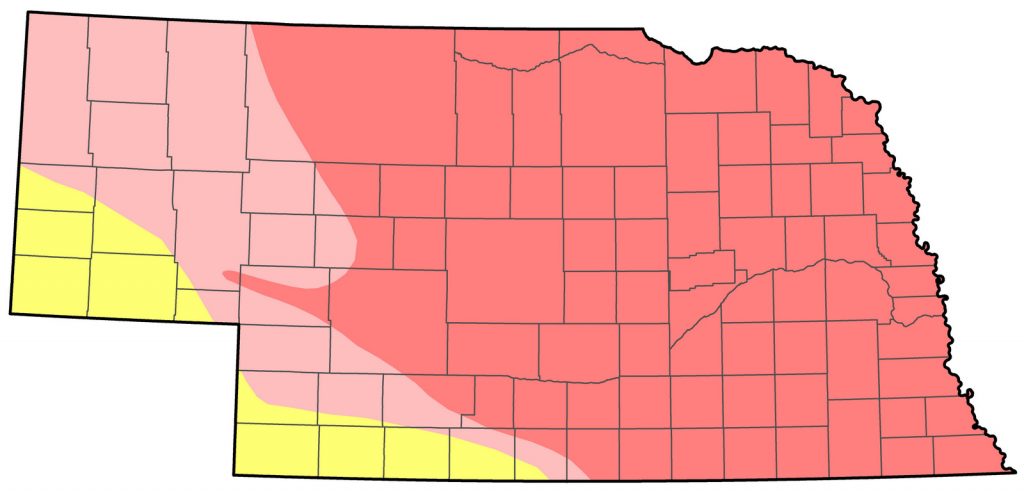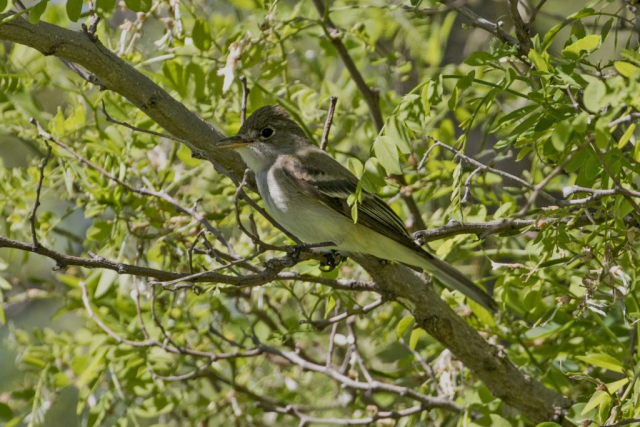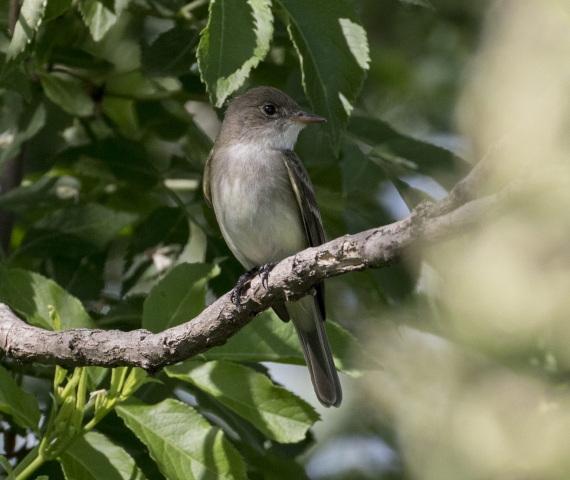Empidonax traillii CAMPESTRIS
Status: Fairly common regular spring migrant east, uncommon central and west. Locally uncommon regular breeder statewide. Uncommon regular fall migrant statewide.
Documentation: Recording: 1 Jun 1968 Fontenelle Forest, Sarpy Co (Bray et al 1986).
Taxonomy: Four subspecies are recognized (AviList 2025), brewsteri from southwest British Columbia to southwest California, adastus, of southern British Columbia to southwest Alberta and south to eastern California and central Colorado, extimus, from southern Nevada to central Colorado and south to southern California and southwest Texas, and traillii from southern Alberta to Maine and south to central Colorado, central Arkansas, and central North Carolina.
A fifth subspecies, campestris, is recognized by some authors; Sedgwick (2020) describes its range as essentially the western half of the range outlined above for traillii, thus including Nebraska.
Nebraska birds are presumed campestris.
This summary uses reports of Willow Flycatcher published since 1973, when Willow Flycatcher and Alder Flycatcher were recognized as different species (Eisenmann 1973). Summer reports of “Empidonax sp.” are included here also, as almost all such reports are likely to pertain to Willow Flycatcher rather than Acadian or Western Flycatchers.
Spring: May 2, 3, 3 <<<>>> summer
Willow Flycatcher is most numerous in the east during spring migration; arrival is in early May and most migrants pass through mid-late May and early Jun. The 2 May date cited above was for a singing bird in Dixon Co in 1999. The presence of summering birds makes determination of the end of migration difficult.
In Kansas, where this species is essentially a migrant, specimens and banded birds are in the period 2 May-18 Jun (Thompson et al 2011); most records are 21-30 May. At Hays, Kansas, 87% of the records were in the period 20-25 May (Ely 1970) and 80% of the records in northeast Kansas were in the period 20-28 May (Cink 1998).
- High counts: 25 along Pawnee Road, Lincoln Co 3 Jun 2024, 21 in Nebraska City, Otoe Co 11 May 2008, 16 in the eastern Rainwater Basin 27 May 2001, and 12 in Lincoln Co 27 May 2013.
Summer: Willow Flycatcher breeds virtually statewide at low density. There are Jun-Jul reports for most of the state, although it is least numerous in the southwest, western Sandhills (eBird.org, accessed Nov 2023), and Rainwater Basin (Jorgensen 2012). The latter author considered Rainwater Basin breeding status “unresolved”, citing “possible” breeding (Mollhoff 2001) and a potential breeding record in Clay Co 18 Jun 2011. Since Jorgensen (2012), additional Rainwater Basin records suggestive of breeding are 12 Jun 2023, 27 Jun 2021, and 28 Jun 2019 in Fillmore Co, and 17 Jun 2019 and 7 Jul 1996 in Clay Co (eBird.org, accessed Nov 2023).
The only breeding season reports from the southwest are from Dundy Co (two locations) 18 Jun 2025, Perkins Co 12 Jun-26 Jul 1974 and 30 Jul 1971, Chase Co 19 Jun 2018 and 24 Jul 2003 (both possibly migrants), and Frontier Co 30 Jun 2023. Summering is rare in northeast Colorado, with most of the few reports along the South Platte River (eBird.org, accessed Nov 2023).
Mollhoff (2016) noted an increase in the number of reports between the first (1984-1989) and second (2006-2012) Breeding Bird Atlases, but also suggested the increase was attributable to increased observer coverage. BBS data supports the notion the species has increased, as trend analysis shows the species has increased annually by 1.36% (95% C.I.; -0.2, 3.46) during the period 1966-2019 (Sauer et al 2020).
- Breeding Phenology:
- Incubation: 10 Jun
- Nest building: 10 Jun
Eggs: 15 Jun-16 Jul (Mollhoff 2022)
Fledglings: 8-31 Jul
- High counts: 6 at Spring Creek Prairie, Lancaster Co 16 Jun 2022, 6 there 6 Jul 2025, and 5 in Lincoln Co 3 Aug 2024.
Fall: summer <<<>>> Sep 18, 19, 20
Later dates are 25 Sep 2022 Lancaster Co, 29 Sep 2018 Chadron SP, Dawes Co, 30 Sep 2018 Lancaster Co, and 25 Sep-5 Oct Lincoln Co.
Migration takes place during Aug, ending in mid-Sep.
While identification of silent fall birds is questionable, most published data are from locations where this species was present during the summer. Kansas specimen dates are in the period 16 Aug-15 Sep and banding data indicate that adults pass through Kansas 23 Jul-16 Aug and juveniles 16 Aug-12 Sep (Thompson et al 2011). Banding dates from northeast Kansas are 28 Jul-18 Sep, peaking in Aug (Cink 1998).
- High counts: 5 at Wind Springs Ranch, Sioux Co 25 Aug 2022.
Images
Abbreviations
BBS: Breeding Bird Survey
SP: State Park
Literature Cited
AviList Core Team, 2025. AviList: The Global Avian Checklist, v2025. https://doi.org/10.2173/avilist.v2025.
Bray, T.E., B.K. Padelford, and W.R. Silcock. 1986. The birds of Nebraska: A critically evaluated list. Published by the authors, Bellevue, Nebraska, USA.
Cink, C.L. 1998. Migration of Least and Traill’s Flycatchers in Northeast Kansas. Abstracts of Papers Presented at the 1999 Fall KOS Meetings Lawrence, Kansas. The Horned Lark 25: 14.
Eisenmann, E. 1973. Thirty-second Supplement to the American Ornithologists’ Union Checklist of North American Birds. Auk 90: 411-419.
Ely, C. 1970. Migration of Least and Traill’s Flycatchers in west-central Kansas. Bird-Banding 41: 198-204.
Jorgensen, J.G. 2012. Birds of the Rainwater Basin, Nebraska. Nebraska Game and Parks Commission — Staff Research Publications. 55.
Mollhoff, W.J. 2001. The Nebraska Breeding Bird Atlas, 1984-1989. Nebraska Ornithologists’ Union, Occasional Papers No. 7/ Nebraska Game and Parks Commission, Technical Series No. 20, Lincoln, Nebraska.
Mollhoff, W.J. 2016. The Second Nebraska Breeding Bird Atlas. Bull. Univ. Nebraska State Museum Vol 29. University of Nebraska State Museum, Lincoln, Nebraska, USA.
Mollhoff, W.J. 2022. Nest records of Nebraska birds. Nebraska Ornithologists’ Union Occasional Paper Number 9.
Sauer, J.R., W.A. Link, and J.E. Hines. 2020. The North American Breeding Bird Survey, Analysis Results 1966 – 2019: U.S. Geological Survey data release, https://doi.org/10.5066/P96A7675.
Sedgwick, J.A. 2020. Willow Flycatcher (Empidonax traillii), version 1.0. In Birds of the World (A. F. Poole and F. B. Gill, Editors). Cornell Lab of Ornithology, Ithaca, NY, USA. https://doi.org/10.2173/bow.wilfly.01.
Thompson, M.C., C.A. Ely, B. Gress, C. Otte, S.T. Patti, D. Seibel, and E.A. Young. 2011. Birds of Kansas. University Press of Kansas, Lawrence, Kansas, USA.
Recommended Citation
Silcock, W.R., and J.G. Jorgensen. 2025. Willow Flycatcher (Empidonax traillii). In Birds of Nebraska — Online. www.BirdsofNebraska.org
Birds of Nebraska – Online
Updated 3 Sep 2025


